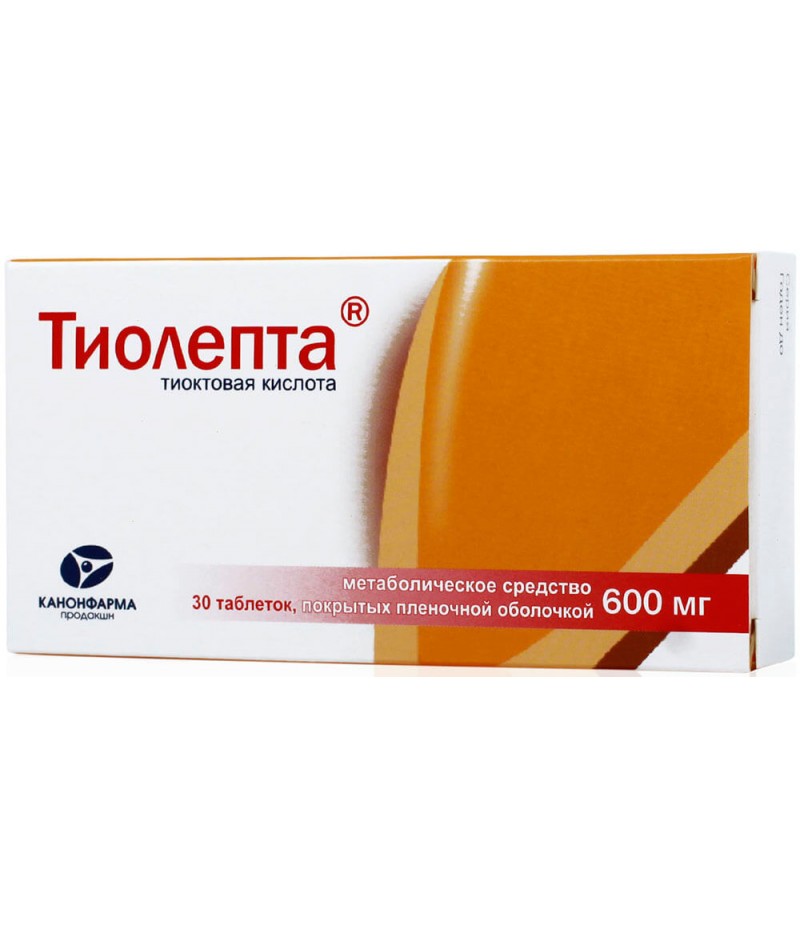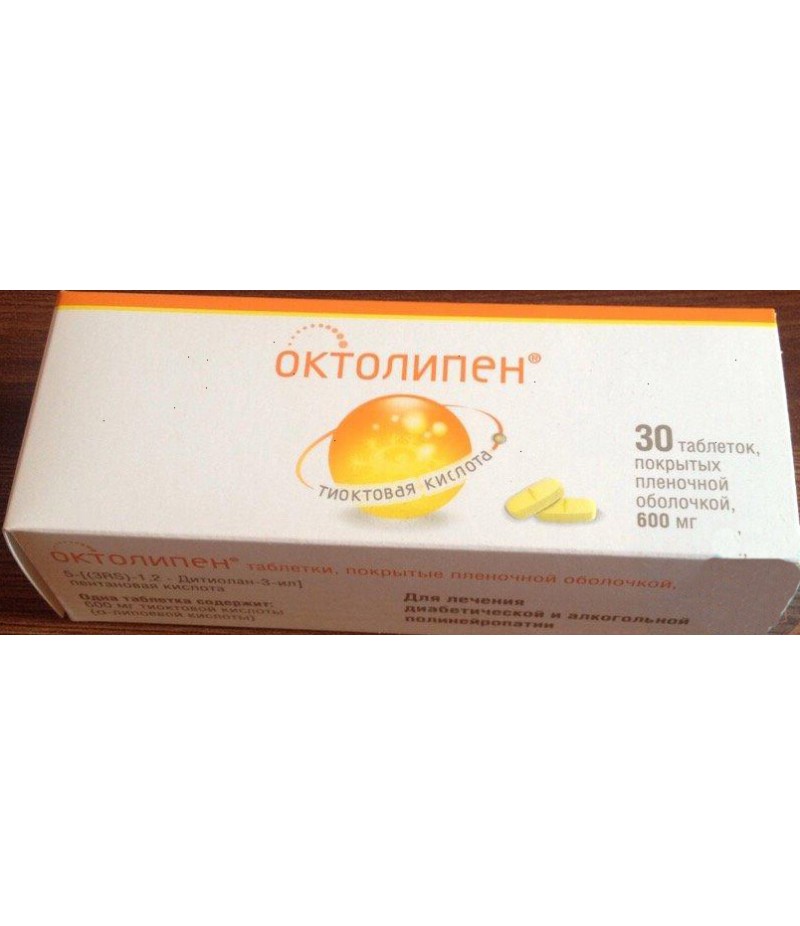Thiolepta tabs 600mg #30
- $37.73
- 3 or more $36.50
- Availability:In Stock
Instruction for ThioleptaYou can buy Thiolepta pills on this pageCompositionThe composition of one tablet, coated with a coating, includes 300 or 600 mg of thioctic acid and auxiliary ingredients: potato starch;&..
Instruction for Thiolepta
You can buy Thiolepta pills on this page
Composition
The composition of one tablet, coated with a coating, includes 300 or 600 mg of thioctic acid and auxiliary ingredients:
potato starch;
colloidal silicon dioxide;
impellosis;
calcium stearate;
lactose;
ICC;
Castor oil.
The film membrane consists of a seroate AQ-01812.
In 1 ml of the solution for infusions contains 12 mg of thioctic acid and auxiliary substances:
15 mg meglumine;
30 mg macrogol;
10 mg of povidone;
water for injections.
Form of issue
Produced in the form of tablets of 300 and 600 mg and a solution for infusion.
Appearance of the medicine:
Thiolepta 300 tablets are round, convex on both sides, covered with a light yellow coat; Packed in contour packs of 10 or 15 tablets, 1, 3, 6 or 9 packs of 10 tablets or 2, 4, 6 to 15 are put in a cardboard box;
Thiolepta 600 tablets are oval, covered with a light yellow coat and light yellow on the fracture; 10 or 15 tablets are placed in a contiguous cell package, 3, 6 packs of 10 tablets or 2, 4 to 15 are put in a cardboard bundle;
solution - a clear liquid of light yellow color, there may be a greenish tinge; poured into bottles of 25 and 50 ml of brown glass, which belongs to the first hydrolytic class, are hermetically sealed, 1, 3, 5, 10 bottles are packed in a cardboard bundle, pendant cases are put for them to protect from light.
pharmachologic effect
It has neurotrophic, antioxidant and metabolic action.
Pharmacodynamics and pharmacokinetics
Pharmacodynamics
Thioktonic acid is able to bind free radicals, improve trophic processes in the nervous tissue, has a hepatoprotective effect. By biochemical action is similar to the effect of vitamin B group vitamins.
It takes part in the normalization of carbohydrate metabolism, contributing to a decrease in blood glucose levels, a decrease in insulin resistance and an increase in glycogen content in the liver. Also, thioctic acid regulates lipid metabolism and causes lower cholesterol levels.
Pharmacokinetics
When taken in the form of tablets, the maximum concentration in the blood will be reached after 40-60 minutes. The drug is completely absorbed in the digestive tract, but the rate of absorption can be slightly slowed by simultaneous intake of food. Bioavailability is 30%.
With intravenous administration, the maximum concentration in the plasma is achieved much faster - in 10-11 minutes.
Metabolism by oxidation and conjugation occurs in the liver. Thioctic acid and substances that are formed from it during metabolism are excreted mainly through the kidneys.
Indications for use
Applied with diabetic and alcoholic polyneuropathy.
Contraindications
Contraindications for the appointment of the drug Thiolepta include:
increased sensitivity to the components of the drug;
pregnancy;
lactation period;
age is less than 18 years.
Among the conditions under which it is possible to prescribe a solution of Thiolepta, but the tablets are contraindicated, doctors call:
lactose intolerance;
lactase insufficiency;
glucose-galactose malabsorption.
Side effects
Side effects of tablets:
from the side of the digestive system, there may be abnormalities in the form of nausea, vomiting, heartburn, diarrhea, abdominal pain;
development of allergic reactions in the form of urticaria, rashes on the skin, itching, systemic reactions (anaphylactic shock);
hypoglycemia, which will manifest dizziness, increased sweating, headache.
Undesirable effects that may occur after administration of the solution:
convulsions;
Duplication of vision (diplopia);
small hemorrhages in the skin and mucous membranes;
thrombocytopenia;
thrombophlebitis;
increased intracranial pressure (with too rapid introduction);
feeling of difficulty breathing;
hypoglycemia;
manifestations of allergy in the form of skin rashes or a systemic reaction.
Thiolepta, instructions for use (Method and dosage)
Thiolepta tablets are taken orally, 600 mg at a time, about half an hour before breakfast, without chewing and not crushing in any other way, washing down with water. The duration of the course of therapy is determined by the doctor.
The solution is administered once a day for 50 ml. It is important to maintain a low rate of administration. It is used for 2-4 weeks. Then they switch to tablets.
Overdose
In case of an overdose, the head starts to ache, nausea appears, vomiting is possible.
Symptoms that indicate a severe overdose (intake 6-40 g):
convulsive seizures;
hypoglycemic coma;
bleeding disorders;
disturbance of acid-base balance, even development to lactic acidosis.
In acute acute overdose, there is a risk of death, so you need to immediately hospitalize a person.
Specific treatment is not. Therapy in case of overdose is aimed at maintaining the vital systems of the body and eliminating visible symptoms.
Interaction
Thioctic acid interacts with some medicines:
with Cisplatin - the effectiveness of cisplatin decreases;
with preparations containing metals, and dairy products - tioktinovaya acid binds metals and calcium, so between taking these drugs and Thiolepta need to withstand an interval of 2 hours;
with insulin, oral hypoglycemic drugs - increased hypoglycemic effect;
with glucocorticosteroids - increases anti-inflammatory effect;
with ethanol and its metabolites - the action of Thiolepta's medication is weakened;
with Ringer's solution, Dextrose, and others that are able to react with disulfide groups - can not be combined with Thiolepta's solution.
Storage conditions
In a dark, dry, cool place.
Shelf life - 3 years.
special instructions
Patients with diabetes mellitus, especially those who take insulin, can be treated only with constant monitoring of blood glucose. If necessary, lower the dose of insulin.
During treatment it is necessary to refrain from alcoholic beverages.
When driving a car and working with mechanisms that require a high reaction speed, you need to be careful.
In pregnancy and lactation
The use of Thiolepta during pregnancy, as well as during the feeding of the child is strictly prohibited, since there is no information as to whether this drug can influence the course of pregnancy and the growth of the child.
Reviews about Thiolepta
The reviews show that the drug helps with taking the course. The degree of effectiveness varies depending on the characteristics of the organism.


